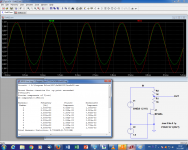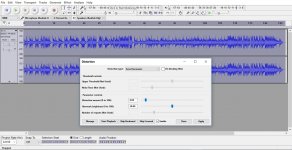Hi everyone,
as the title suggests, i want to create (on purpose ) second harmonic distortion, preferably on a line signal level.
) second harmonic distortion, preferably on a line signal level.
What would be an easy way to accomplish this? I would also very much like to be able to control the amount of the effect (the percentage of the 2nd harmonic).
I thought of using something like a misbiased emitter follower or something similar. Can anyone think of an easier way to do it?
The reason for this weird quest, is that i would like to "study" the effects of 2nd harmonic distortion on real music, to listen and learn what it sounds like, and hopefully understand why some people kind of like it, or at least don't get bothered by it (choob lovers etc...).
Also, could this be done in audacity? (i'm a little lazy )
)
Thanks very much for any info.
as the title suggests, i want to create (on purpose
What would be an easy way to accomplish this? I would also very much like to be able to control the amount of the effect (the percentage of the 2nd harmonic).
I thought of using something like a misbiased emitter follower or something similar. Can anyone think of an easier way to do it?
The reason for this weird quest, is that i would like to "study" the effects of 2nd harmonic distortion on real music, to listen and learn what it sounds like, and hopefully understand why some people kind of like it, or at least don't get bothered by it (choob lovers etc...).
Also, could this be done in audacity? (i'm a little lazy
Thanks very much for any info.
maybe worth a read:
Soft Clipping
I have read this article, but soft clippers produce predominantly odd harmonics. Are you suggesting a single diode soft clipper?
Symmetrical clippers produce mainly odd harmonics.
Unsymmetrical clippers produced mainly even harmonics.
Sharp clipping produces high order harmonics.
Soft/rounded clipping or curve nonlinearity produce lower order harmonics.
So in a nutshell, you will not produce just second harmonic and nothing else, but with careful selection of parameters you can produce relatively soft and "musical" lower order even harmonics.
That´s the generic recipe, now you will have to shake your lazyness , and read and experiment a lot
, and read and experiment a lot 
Unsymmetrical clippers produced mainly even harmonics.
Sharp clipping produces high order harmonics.
Soft/rounded clipping or curve nonlinearity produce lower order harmonics.
So in a nutshell, you will not produce just second harmonic and nothing else, but with careful selection of parameters you can produce relatively soft and "musical" lower order even harmonics.
That´s the generic recipe, now you will have to shake your lazyness
A single ended stage with resistor loading, that is driven to near the supply rails will produce a very distorted sinewave. Most of that distortion is 2nd harmonic.
At low levels the distortion is very low, at medium levels the distortion is just about audible.
At high level the distortion is gross.
Is there a circuit that adds a nearly constant proportion of 2nd harmonic?
At low levels the distortion is very low, at medium levels the distortion is just about audible.
At high level the distortion is gross.
Is there a circuit that adds a nearly constant proportion of 2nd harmonic?
You can insert this halfwave/soft clipper in the signal line: it is almost passive, just requiring a static bias requiring no current (a battery or a big cap), produces ~90% second harmonic, and has many parameters to play with, to adjust the distortion profile:
-The values of R1 R2
-The tap ratio if you use a potentiometer
-The negative bias voltage
-The values of R1 R2
-The tap ratio if you use a potentiometer
-The negative bias voltage
Attachments
You can play around with this in Audacity. Try 3 or 6db for a start, save your file under another name and then compare using an ABX comparator such as Foobar.
For a real circuit I would go with a JFET as in post #5.
You can even try that for real by simulating it in LTSpice (make a stereo pair) and applying a .wav file to the sim and then capturing the output.
For a real circuit I would go with a JFET as in post #5.
You can even try that for real by simulating it in LTSpice (make a stereo pair) and applying a .wav file to the sim and then capturing the output.
Attachments
I tried in audacity, i couldn't find that specific "distortion" plugin, but i tried "diode processor" using half wave settings. To my ears, at low levels the distortion is not that bad, it's kind of bearable. At higher levels it just sounds distorted, and at full wave settings it is just unbearable.
I alse tried "harmonic generator" with similar results. Odd order harmonics just sound harsh and evil, even order harmonics are more bearable (especially low order, the higher you go in order, the worse it gets) but still sound distorted/bad.
I'm already wondering, who and why would prefer a slightly distorted signal over a nice and clean one? (except maybe guitar players)
I alse tried "harmonic generator" with similar results. Odd order harmonics just sound harsh and evil, even order harmonics are more bearable (especially low order, the higher you go in order, the worse it gets) but still sound distorted/bad.
I'm already wondering, who and why would prefer a slightly distorted signal over a nice and clean one? (except maybe guitar players)
A possible reason is that people prefer to listen to the sound that they are used to. So someone who grew up when thermionic valves were the height of technology will enjoy the sound of 2nd harmonic distortion....I'm already wondering, who and why would prefer a slightly distorted signal over a nice and clean one? (except maybe guitar players)
Hi everyone,
as the title suggests, i want to create (on purpose) second harmonic distortion, preferably on a line signal level...
Here you go. This what you are looking for ... You Can DIY! Build the Mojo Maestro
A possible reason is that people prefer to listen to the sound that they are used to. So someone who grew up when thermionic valves were the height of technology will enjoy the sound of 2nd harmonic distortion.
And there's your answer: tubes.
A lot of guitarists love their tube amps because they contribute so much ("euphomic" distortion) to the tone. The "classic" live rock sound is just big stacks of big speakers driven by an array of 60-120 watt tube amps.
I've no idea. If you are reproducing the harmonics already in the music (impossible not to) there is no reason to add more
This is way to common. Removing the recording chain from the playback chain. Its one chain .
Moving a mic or an instrument can change the harmonic content being recorded.(not to mention using different mics or EQ etc.) Its up to the recording engineer. If I like more harmonics than the engineer, why not add them? I have no problem with that. Personally I want to hear what the artists and production team heard in the mix session. Unfortunately thats impossible so the closest I can come is the straight wire for the electronics part. Even thats a guess,they may have used tube amps to mix to.
And there's your answer: tubes.
A lot of guitarists love their tube amps because they contribute so much ("euphomic" distortion) to the tone. The "classic" live rock sound is just big stacks of big speakers driven by an array of 60-120 watt tube amps.
??? Then run your music thru a guitar amp with the drive cranked. See how long that lasts in your system.
Using an opamp, three resistors, and two diodes, build an inverting amplifier circuit whose gain is -2X for the upper half of the input waveform, and whose gain is -4X for the lower half of the input waveform. Voila, 2nd harmonic distortion. Works best for line level signals as requested in post #1.
- Status
- This old topic is closed. If you want to reopen this topic, contact a moderator using the "Report Post" button.
- Home
- Source & Line
- Analog Line Level
- How do i create second harmonic distortion?

